Murchison Falls National Park was established in 1952 and is the largest park in Uganda covering an area of 1,503 square miles. It is found in northwestern Uganda in the Districts of Kiryandongo, Masindi, Nwoya and Buliisa. The River Nile flows through the park dividing it in two and leaving behind beautiful waterfalls. The British Explorer Sir Samuel Baker was stunned by one of waterfalls in the park and gave it the name Murchison Falls which later given to the park.
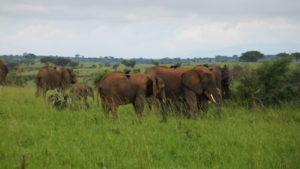 After differences with the western world because of his human rights record, the Ugandan dictator Idi Amin attempted to rename the falls Kabarega (after the King of Bunyoro) but this only lasted during his regime. Murchison Falls National Park largely consists of Savannah grasslands, woodlands, open plains and wetlands. The park is part of the wider Murchison Falls Conservation area that also includes Karuma Falls and Bugungu Wildlife Reserves. It has large forests like Budongo, Rabango and Kaniyo Pabidi. Kaniyo Pabidi contains large mahogany and ironwood trees. All three forests are known for hosting numerous bird and primates species like Chimpanzees, blue monkeys, olive baboons, black and white colobus monkeys.
After differences with the western world because of his human rights record, the Ugandan dictator Idi Amin attempted to rename the falls Kabarega (after the King of Bunyoro) but this only lasted during his regime. Murchison Falls National Park largely consists of Savannah grasslands, woodlands, open plains and wetlands. The park is part of the wider Murchison Falls Conservation area that also includes Karuma Falls and Bugungu Wildlife Reserves. It has large forests like Budongo, Rabango and Kaniyo Pabidi. Kaniyo Pabidi contains large mahogany and ironwood trees. All three forests are known for hosting numerous bird and primates species like Chimpanzees, blue monkeys, olive baboons, black and white colobus monkeys.
The Murchison Conservation Area has the largest number of crocodiles and Roskilde Giraffe in Uganda. The park is a lion conservation unit with 76 species of mammals and over 445 of birds. During the regime of Idi Amin in the 1970’s, a large number of mammals were lost due to uncontrolled poaching and hunting for sport and meat. The few white Rhinos that roamed the park were virtually made extinct although there is an attempt at reintroducing them to the park from the Ziwa Rhino Sanctuary near the park. The Uganda Wildlife Authority has attempted to eliminate poaching in the park but the vice is still prevalent, though on a small scale primarily for bush meat. The park was also affected by the Kony rebellion in Northern Uganda during the 1990’s with some countries declaring it a no go area for their citizens. Peace has returned to every part of the country since 2005 and the number of tourists has increased significantly. The key attractions are the Savannah grasslands, Murchison falls, Karuma falls, river Nile, forests like Kaniyo Pabidi, Budongo and Rabongo.
How reach Murchison Falls National Park
It takes about 4 hours of driving by road to reach Murchison Falls National Park from Kampala. The road from Kampala to the park is well paved although the section leading to the park is made of hard soil. Travelers can use public means of transport like buses, a personal car or the services of a tour operator. No public buses go inside the park. 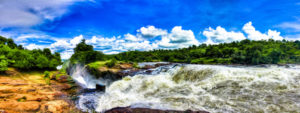 From Kampala a traveler needs to take a bus to Masindi town and then take a small commuter bus up to Paraa. From Paraa, a visitor would need to hire a private car to use for activities within the park. Park entrance costs $40 for international visitors. Public transport can be inconveniencing in a developing country like Uganda because the buses never keep
From Kampala a traveler needs to take a bus to Masindi town and then take a small commuter bus up to Paraa. From Paraa, a visitor would need to hire a private car to use for activities within the park. Park entrance costs $40 for international visitors. Public transport can be inconveniencing in a developing country like Uganda because the buses never keep 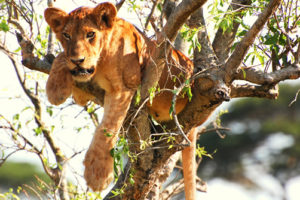 time and make unplanned stoppages to pick and drop passengers. It is highly recommended that you either hire a private car right from Kampala or use the services of a tour company. There are also chartered flights from Entebbe or Kajjansi to small airstrips in Pakuba near the Northern bank of river Nile or Bugungu near the park headquarters. From these points one needs to travel by car to the park headquarters in Paraa or to their lodge. Murchison falls is closer to Kidepo than many of the other major national parks in Uganda. You can go for a 6 Days tour of Murchison Falls and Kidepo National Park to experience most of what Uganda has to offer.
time and make unplanned stoppages to pick and drop passengers. It is highly recommended that you either hire a private car right from Kampala or use the services of a tour company. There are also chartered flights from Entebbe or Kajjansi to small airstrips in Pakuba near the Northern bank of river Nile or Bugungu near the park headquarters. From these points one needs to travel by car to the park headquarters in Paraa or to their lodge. Murchison falls is closer to Kidepo than many of the other major national parks in Uganda. You can go for a 6 Days tour of Murchison Falls and Kidepo National Park to experience most of what Uganda has to offer.
Main Attractions in Murchison Falls National Park
Visitors planning on a safari to Murchison Falls National park should expect to get involved in activities like walking to the top of the Murchison Falls, game drives, bird-watching, chimpanzee trekking, nature walks, fishing, boat cruises and camping among others. A 3 Days safari to Murchison Falls may not be enough for one to complete all the activities in such a large game park. One would need to at least 6 days. Let’s discuss some of the activities in greater detail:-
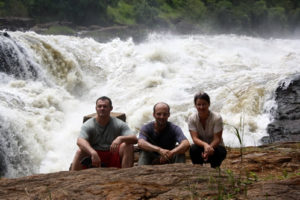 Visiting the Top of the Murchison Falls: The first activity most visitors do is to visit the top of the falls. The Murchison Falls form when the river Nile squeezes through a narrow gorge as it makes its way to Egypt. It is arguably one of the most powerful waterfall in the world after the Victoria falls. One does not need a guide to go to the top of the falls though it is important to move with a team or someone knowledgeable about the area. The first sight of the falls from the top is amazing. The thunderous roar as the water forces its way through the gorge before falling 42 meters below is one of the most memorable moments while in the park. The mist resulting from the force of the water combines with the suns raise to form spectacular rainbows which are awesome to watch.
Visiting the Top of the Murchison Falls: The first activity most visitors do is to visit the top of the falls. The Murchison Falls form when the river Nile squeezes through a narrow gorge as it makes its way to Egypt. It is arguably one of the most powerful waterfall in the world after the Victoria falls. One does not need a guide to go to the top of the falls though it is important to move with a team or someone knowledgeable about the area. The first sight of the falls from the top is amazing. The thunderous roar as the water forces its way through the gorge before falling 42 meters below is one of the most memorable moments while in the park. The mist resulting from the force of the water combines with the suns raise to form spectacular rainbows which are awesome to watch. 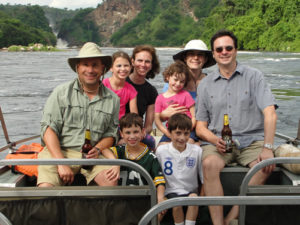 On a hot day or during the dry season, the mist from the waterfall has a cooling and calming effect especially after a long day of activities. This area is great for photography and you shouldn’t be there without a camera. After looking at the waterfall from the top, there is path that leads down to the river or to the smaller Uhuru Falls before the Murchison Falls. One spot not to miss is “the crocodile bar”. This is an area towards the bottom of the falls where crocodiles gather to wait for unlucky animals and fish that are accidentally dragged down by the powerful water. Crocodiles of all sizes lay patiently waiting for the next victims.
On a hot day or during the dry season, the mist from the waterfall has a cooling and calming effect especially after a long day of activities. This area is great for photography and you shouldn’t be there without a camera. After looking at the waterfall from the top, there is path that leads down to the river or to the smaller Uhuru Falls before the Murchison Falls. One spot not to miss is “the crocodile bar”. This is an area towards the bottom of the falls where crocodiles gather to wait for unlucky animals and fish that are accidentally dragged down by the powerful water. Crocodiles of all sizes lay patiently waiting for the next victims.
Boat Cruise at the bottom of the falls: This is one of the most popular activities while at the park and is similar to the launch cruise at the Kazinga Channel of Queen Elizabeth National Park. The cruise lasts about 3 hours starting and ending at the bottom of the falls. The top of the falls offers a breathtaking view of the waterfall and the loud roars coming from the water rushing down to the river. 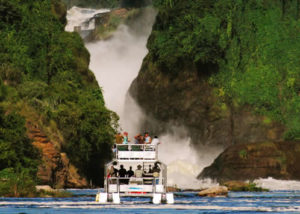 The section of the Nile after the falls shores has abundant wildlife and some of the greatest collection of hippos and crocodiles in Africa. Visitors can also see buffaloes, elephants and various species of antelopes drinking by the shores of the river. The water birds include bee-eaters, cormorants, ducks, fish eagles, herons, kingfishers and shoebill Storks. After taking photos and seeing enough of the birds and animals, the captain will turn the boat upstream to bottom of the falls for visitors to disembark and climb up to level ground.
The section of the Nile after the falls shores has abundant wildlife and some of the greatest collection of hippos and crocodiles in Africa. Visitors can also see buffaloes, elephants and various species of antelopes drinking by the shores of the river. The water birds include bee-eaters, cormorants, ducks, fish eagles, herons, kingfishers and shoebill Storks. After taking photos and seeing enough of the birds and animals, the captain will turn the boat upstream to bottom of the falls for visitors to disembark and climb up to level ground.
Boat ride to the Nile Delta: The Nile Delta is the point where the River Nile connects to Lake Albert. The boat ride to the Nile Delta involves going further upstream beyond the point where the boats used for the normal cruise make a turn. This activity requires sparing half a day and is a must for birders. Visitors usually take a boat downstream on the Nile until the point where it enters Lake Albert. On the way to the lake, there are opportunities to spot more mammals congregating to drink by the shores of the river Nile and birds at the papyrus swamps around Lake Albert. The areas around the Nile Delta are home to several bird species including the rare shoebill stork.
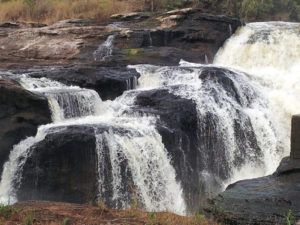 Karuma Falls: These falls are found in the north-eastern section of the game park near Gulu district. The falls form at a point where the river Nile squeezes through several rocky formations before dropping with a roaring sound. The foamy water resulting from the contact between the rushing river and rocks are beautiful to behold. Moreover the area attracts several bird species and animals like the baboons, buffaloes, elephants, giraffes, Leopards, lions, monkeys, antelopes like the Uganda Kob and Hartbeest.
Karuma Falls: These falls are found in the north-eastern section of the game park near Gulu district. The falls form at a point where the river Nile squeezes through several rocky formations before dropping with a roaring sound. The foamy water resulting from the contact between the rushing river and rocks are beautiful to behold. Moreover the area attracts several bird species and animals like the baboons, buffaloes, elephants, giraffes, Leopards, lions, monkeys, antelopes like the Uganda Kob and Hartbeest.
Game Drives: This is arguably the most enjoyable activity in the park. Game drives can be done alone although the presence of a ranger from the park turns it into a more educative activity because they can help identify the types of birds and mammals or take you to the best places to find them. While on a 3 hour game rive to Murchison Falls, expect to spot animals like buffaloes, crocodiles, elephants, giraffes, Hippopotamus, Leopards, lions, Monitor lizards, Side Striped Jackals, Spotted Hyenas and warthogs.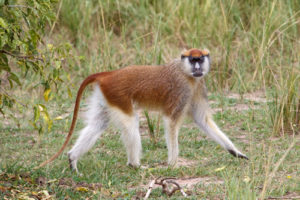 Among the antelope species in the park include the Bohor Reedbuck, Bushbuck, Defassa Waterbuck, Hartebeest, Oribi and the Uganda Kob among others. The primate species in the park include Baboons, Black and White Colobus, Patas Monkeys, Vervet Monkeys and Chimpanzees in the Rabongo and Budongo Forests. The park also has reptiles like the African rock python, mambas, cobras and other smaller snakes.
Among the antelope species in the park include the Bohor Reedbuck, Bushbuck, Defassa Waterbuck, Hartebeest, Oribi and the Uganda Kob among others. The primate species in the park include Baboons, Black and White Colobus, Patas Monkeys, Vervet Monkeys and Chimpanzees in the Rabongo and Budongo Forests. The park also has reptiles like the African rock python, mambas, cobras and other smaller snakes.
Apart from the day game drives, visitors can also choose to go for the two hour night game drive. While on the night game drive, the chances of seeing predators like hyenas, lions, serval cats and particularly leopards become higher. The rangers move with spotlights so that any action is not missed. The night game drives start late in the evening or when it gets dark.
Rhino tracking at the Ziwa Rhino Sanctuary: The Ziwa Rhino sanctuary is located along the way to the Murchison Falls national park from Kampala. Due to extensive poaching, rhino’s no longer roam Uganda’s national parks. The Ziwa Rhino sanctuary was established to protect the remaining rhinos and increasing the numbers through careful breeding before reintroducing them to the larger parks once their numbers reach 20. Tracking rhinos on foot is the main activity here and is usually supervised by rangers from the sanctuary. The Rangers share information about Rhinoceros, the history of the sanctuary, the breeding programme and the wider conservation efforts. They then lead visitors to see the large mammals up-close as they feed. Apart from Rhinos, there are small primates and bird species that call the vast sanctuary home. Visitors can also take nature walks to see birds like the Shoebill Stork. All proceeds from the visitors are channeled to Rhino conservation efforts. Visiting the Ziwa Rhino Sanctuary is best done before or after a 2 day safari in Murchison Falls National Park.
Fishing: The area below the Murchison Falls is one of the best places for fishing in Uganda. Huge Nile Perch weighing over 200 pounds can still be caught in this part of the Nile. The other common specie caught here is the Tiger fish and Tilapia. Visitors can go fishing on river Nile by boat or stand at the bottom of the Murchison falls itself and through their line. Fishing can also be arranged at the Karuma falls or one of the pools on the riverside. Visitors need to acquire a fishing license and bring their own fishing gear. In order to catch the Nile Perch, smaller fish need to be first caught and used as bait. Fishing can be combined with game drives and boat cruises in our 4 days Murchison falls wildlife safari package.
Forest and nature Walk: These forests walks are suitable for educational purposes and can be done in Chobe or more preferably in Rabongo and Budongo forest. These two forests have several bird species and primates like Chimpanzee and monkeys. The walks should be led by an experienced guide or ranger who is knowledgeable about the different species of birds, trees and animals.
Birdwatching: Murchison Falls Park is one of the best places for birding in Uganda. The activity can be done during the nature walks or using a safari vehicle. As a large park, the Murchison Falls provides countless opportunities and places to go birding. It could start right outside your lodge, then to the Savannah grasslands, the forests and the river Nile. 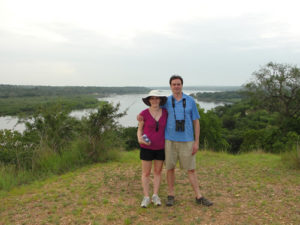 Birdwatching can also be done at Kaniyo Pabidi forest area. The bird species in the park include the Abdim’s Stork, Abyssinian Ground Hornbill, African Darter, African Fish Eagle, African Jacana, African Quail-Finch, African Skimmer, Bar-breasted Firefinch, Beautiful Sunbird, Black Crake, Black Scimitarbill, Black-billed Barbet, Black-billed Wood-Dove, Black-faced Waxbill, Black-headed Batis, Black-headed Gondola, Black-headed Gonolek, Black-headed Plover, Black-lored Babbler, Blue-headed Coucal, Blue-naped Moosebird, Bluff-bellied Warbler, Chestnut-crowned Sparrow Weaver, Dark Chanting-Goshawk, Denham’s Bustard, Double-toothed Barbet, Eastern Grey Plantain-Eater, Fawn-breasted Waxbill, Giant Kingfisher, Goliath Heron, Gray Crowned crane, Green-winged Ptyilia, Grey Crowned Cranes, Grey-headed Bush Shrike, Hugli’s Francolin, Long Tailed Nightjar, Long-toed Plover, Malachite Kingfisher, Martial Eagle, Northern Carmine Bee-eater, Nothern Crombec, Osprey, Pel’s Fishing Owl, Pennant-winged Nightjar, Piapiac, Pied Kingfisher, Red-throated Bee-Eater, Red-throated Bee-eater, Red-winged Grey Warbler, Rock Pratincole, Sacred Ibis, Saddle-billed Stork, Sandpipers, Secretary Bird, Senegal Thick-knee, Shoebill Stork, Silver Bird, Bluff-bellied Warbler, Speckle-fronted Weaver, Speckle-fronted Weaver, Spotted Mourning Thrush, Spotted owl, Spotted Thick-knee, Spur-winger Geese, Squacco Heron, Standard-winged Nightjar, Sulphur-breasted Bush Shrike, Swallow-tailed Bee-eater, Swamp Flycatcher, Vaseline Masked Weaver, Veracious Dove, Verreaux’s Owl, Vitelline Masked Weaver, Weaver Birds, Whistling Cisticola, White African fish eagle, White-backed Night Heron, White-browed Sparrow Weaver, White-faced Whistling Duck, White-fronted Black Chat, White-rumped Seed-eater, Yellow-billed Stork, Yellow-fronted Tinkerbird and Yellow-throated Greenbul among others.
Birdwatching can also be done at Kaniyo Pabidi forest area. The bird species in the park include the Abdim’s Stork, Abyssinian Ground Hornbill, African Darter, African Fish Eagle, African Jacana, African Quail-Finch, African Skimmer, Bar-breasted Firefinch, Beautiful Sunbird, Black Crake, Black Scimitarbill, Black-billed Barbet, Black-billed Wood-Dove, Black-faced Waxbill, Black-headed Batis, Black-headed Gondola, Black-headed Gonolek, Black-headed Plover, Black-lored Babbler, Blue-headed Coucal, Blue-naped Moosebird, Bluff-bellied Warbler, Chestnut-crowned Sparrow Weaver, Dark Chanting-Goshawk, Denham’s Bustard, Double-toothed Barbet, Eastern Grey Plantain-Eater, Fawn-breasted Waxbill, Giant Kingfisher, Goliath Heron, Gray Crowned crane, Green-winged Ptyilia, Grey Crowned Cranes, Grey-headed Bush Shrike, Hugli’s Francolin, Long Tailed Nightjar, Long-toed Plover, Malachite Kingfisher, Martial Eagle, Northern Carmine Bee-eater, Nothern Crombec, Osprey, Pel’s Fishing Owl, Pennant-winged Nightjar, Piapiac, Pied Kingfisher, Red-throated Bee-Eater, Red-throated Bee-eater, Red-winged Grey Warbler, Rock Pratincole, Sacred Ibis, Saddle-billed Stork, Sandpipers, Secretary Bird, Senegal Thick-knee, Shoebill Stork, Silver Bird, Bluff-bellied Warbler, Speckle-fronted Weaver, Speckle-fronted Weaver, Spotted Mourning Thrush, Spotted owl, Spotted Thick-knee, Spur-winger Geese, Squacco Heron, Standard-winged Nightjar, Sulphur-breasted Bush Shrike, Swallow-tailed Bee-eater, Swamp Flycatcher, Vaseline Masked Weaver, Veracious Dove, Verreaux’s Owl, Vitelline Masked Weaver, Weaver Birds, Whistling Cisticola, White African fish eagle, White-backed Night Heron, White-browed Sparrow Weaver, White-faced Whistling Duck, White-fronted Black Chat, White-rumped Seed-eater, Yellow-billed Stork, Yellow-fronted Tinkerbird and Yellow-throated Greenbul among others.
Chimp Trekking in Budongo forest: Budongo Forest is found south of the park and is part of the Budongo and Kaniyo Pabidi forest reserve. The forest has over 464 species of plants and mammals including over 820 chimpanzees. There is a research station by Jane Goodall in Budongo forest and hence tracking chimpanzees is the most popular activity in the forest. 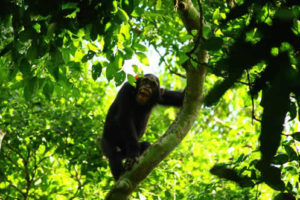 Chimpanzee tracking starts at 8am and ends at around 3pm. The chances of seeing the chimps are high but will depend on the season of the year. The best time to see the chimp’s are in May and August. The activity can go on for long but trackers should never be bored in such a beautiful forest with birds (over 360 species) and smaller primates like the black and white colobus, blue monkey, forest galago, pattos and red-tailed monkeys. An experienced and well-informed guide usually leads visitors to help them identify the different species of birds, animals and vegetation. The chimpanzee habituation experience can also be arranged in Budongo forest during periods with fewer trackers. The cost of chimpanzee trekking permits in Budongo is $130. If you are interested in combining a safari and tacking the chimps, you might want to check out our 6 Days safari in Murchison falls and chimpanzee tracking in Budongo package.
Chimpanzee tracking starts at 8am and ends at around 3pm. The chances of seeing the chimps are high but will depend on the season of the year. The best time to see the chimp’s are in May and August. The activity can go on for long but trackers should never be bored in such a beautiful forest with birds (over 360 species) and smaller primates like the black and white colobus, blue monkey, forest galago, pattos and red-tailed monkeys. An experienced and well-informed guide usually leads visitors to help them identify the different species of birds, animals and vegetation. The chimpanzee habituation experience can also be arranged in Budongo forest during periods with fewer trackers. The cost of chimpanzee trekking permits in Budongo is $130. If you are interested in combining a safari and tacking the chimps, you might want to check out our 6 Days safari in Murchison falls and chimpanzee tracking in Budongo package.
Hot Air Balloon Wildlife viewing: Murchison Falls is the only park where one can go for a hot air balloon safari in Uganda. This activity starts early in the morning with the gathering and inflating of the balloon. Tourists then undergo briefing on safety issues before taking off. The activity lasts about one hour and provides opportunities to spot and take photos of the wildlife and forests from above ground. It is breathtaking gliding over vast herds of giraffes, elephants, buffaloes, antelopes and the main predators coming back from the nights hunt. At the end of the activity tourists come out having seen more animals than during the usual game drives. Visitors are entitled to receive a certificate of participation at the end of the activity. The company responsible for running the balloon safari is Dream balloons but with supervision from the Uganda Civil Aviation Authority.
Camping: Camping can be arranged within the lodges but more preferably in the wilderness or forest like Kaniyo Pabidi. Campers are provided with firewood, water and tents. You may need to bring your own food and equipment although you can get them on arrangement with your lodge or park authorities.
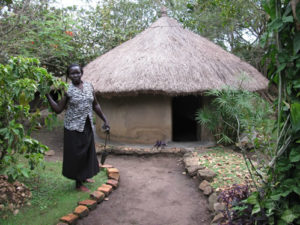 Cultural visit to Boomu Village: This activity is arranged for a few hours or a whole days with the Boomu Women’s group. The group organizes village tours, accommodation and a shop for African art. The village walks offer opportunities to mingle and interact with locals living in the village. One can also stay for the night and experience what it is like sleeping in a traditional African hut with a rural African family. After spending the night with the family, the visitor can wake up and help with garden work or cook with the village women.
Cultural visit to Boomu Village: This activity is arranged for a few hours or a whole days with the Boomu Women’s group. The group organizes village tours, accommodation and a shop for African art. The village walks offer opportunities to mingle and interact with locals living in the village. One can also stay for the night and experience what it is like sleeping in a traditional African hut with a rural African family. After spending the night with the family, the visitor can wake up and help with garden work or cook with the village women.
Accommodation in Murchison Falls National Park
There are a variety of lodges, campsites and hotels offering accommodation facilities within and outside Murchison Falls National Park. The final choice of accommodation facility depends entirely on a traveler’s budget. The best lodges are those near the river Nile or in areas near where the game drives are arranged. Let’s look at some of the hotels and lodges.
Nile Safari Lodge: The lodge is built near the western boundary of the park and is surrounded by a papyrus forest. This luxury camp overlooks the river Nile on the southern bank and consists of six tents, cottages and a large pool for swimming. The tents are self-contained with hot showers and balconies overlooking wilderness and the river Nile. Other facilities include a bar, a restaurant and a beautiful compound garden. An evening campfire is usually set up where traditional dancers are hired to entertain guests.
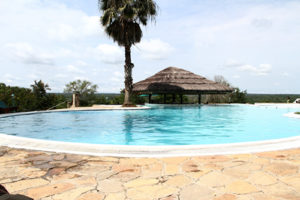 Paraa Safari Lodge: Paraa Safari lodge is one of the oldest and most established lodges in the Murchison Falls area. It has more than 53 luxury self-contained rooms that are decorated with local African art. The rooms have a balcony that overlooks the Nile on its northern bank. Other facilities include a swimming pool, a bar, restaurant and well manicured gardens. Clients are served three meals each day consisting of both international cuisines and local dishes. The lodge is located in a convenient place to do game drives, sport fishing and boat cruises along the Nile River. Because of its closeness to the Nile, it is possible to spot animals like buffaloes and elephants taking a bath by the riverside.
Paraa Safari Lodge: Paraa Safari lodge is one of the oldest and most established lodges in the Murchison Falls area. It has more than 53 luxury self-contained rooms that are decorated with local African art. The rooms have a balcony that overlooks the Nile on its northern bank. Other facilities include a swimming pool, a bar, restaurant and well manicured gardens. Clients are served three meals each day consisting of both international cuisines and local dishes. The lodge is located in a convenient place to do game drives, sport fishing and boat cruises along the Nile River. Because of its closeness to the Nile, it is possible to spot animals like buffaloes and elephants taking a bath by the riverside.
Red Chilli Rest Camp: Formerly known as Paraa Rest Camp, this facility is built on the southern section of the river Nile. The rooms are self-contained and made of brick and grass thatched roofs. Some of the facilities in the hotel include a cooking section, toilets, a restaurant and a bar. A camp fire is usually set late in the evening with barbecue. Because of its strategic location within the park, it is possible to spot some of the park animals like antelopes, warthogs and birds coming near the camp.
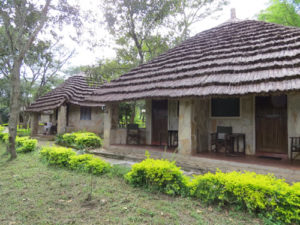 Sambiya River Lodge: This lodge offers budget accommodation. It is built near the Masindi-Paraa road just near the Murchison Falls. The lodge has 26 cottages that are self-contained with showers and large balconies. From the balconies, one can spot game and the nearby Sambiya River. Other facilities include a restaurant, dining area, a bar and a swimming pool. Food is served near the swimming pool. Those who are planning to spot birds and track chimpanzees at Budongo forest will find staying in this lodge very convenient.
Sambiya River Lodge: This lodge offers budget accommodation. It is built near the Masindi-Paraa road just near the Murchison Falls. The lodge has 26 cottages that are self-contained with showers and large balconies. From the balconies, one can spot game and the nearby Sambiya River. Other facilities include a restaurant, dining area, a bar and a swimming pool. Food is served near the swimming pool. Those who are planning to spot birds and track chimpanzees at Budongo forest will find staying in this lodge very convenient.
Pakuba Safari Lodge: This lodge is also built on the banks of the river Nile and has 46 self-contained rooms with their own bathrooms. Some of the rooms can be shared by two people or a family. The lodge has large rooms for social gatherings, conference meetings or weddings. There are special offers for those who stay for 3 or more nights like free game drives, boat cruises, chimpanzee tracking and nature walks on top of the falls
Murchison River Lodge: Murchison River Lodge has double, singe and dormitory rooms that are surrounded by large gardens. The hotel has a bar, swimming pool and large balconies allowing for great views of the landscape. There is free WiFi, a place for keeping luggage, a pool table and flat TV screens.
Masindi Hotel: This hotel is located in the town of Masindi and is suitable for those who arrive late and cannot immediately proceed to the park. Masindi hotel has twenty two rooms that offer mid-range service. The hotel was built during the colonial era but has been renovated with a modern touch.
